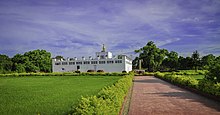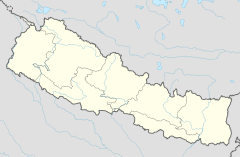
Siddhartha Gautama, most commonly referred to as the Buddha, was a wandering ascetic and religious teacher who lived in South Asia during the 6th or 5th century BCE and founded Buddhism.
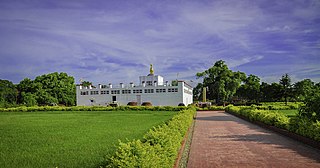
Lumbinī is a Buddhist pilgrimage site in the Rupandehi District of Lumbini Province in Nepal. It is the place where, according to Buddhist tradition, queen Maya gave birth to Siddhartha Gautama at around 566 BCE. Gautama, who, according to Buddhist tradition, achieved Enlightenment some time around 528 BCE, became Shakyamuni Buddha and founded Buddhism. Lumbini is one of many magnets for pilgrimage that sprang up in places pivotal to the life of the Buddha.
Buddhism in Nepal started spreading since the reign of Ashoka through Indian and Tibetan missionaries. The Kiratas were the first people in Nepal who embraced Gautama Buddha’s teachings, followed by the Licchavis and Newar people. Buddha was born in Lumbini in the Shakya Kingdom. Lumbini is considered to lie in present-day Rupandehi District, Lumbini zone of Nepal. Buddhism is the second-largest religion in Nepal. According to 2001 census, 10.74% of Nepal's population practiced Buddhism, consisting mainly of Tibeto-Burman-speaking ethnicities, the Newar. However, in the 2011 census, Buddhists made up just 9% of the country's population.

Śuddhodana, meaning "he who grows pure rice," was the father of Siddhartha Gautama, better known as the Buddha. He was a leader of the Shakya, who lived in an oligarchic republic, with their capital at Kapilavastu.

Maya, also known as Māhāmāyā and Māyādevī, was the queen of Shakya and the birth mother of Gautama Buddha, the sage on whose teachings Buddhism was founded. She was the wife of Śuddhodana, the king of the Shakya kingdom. She was sister of Mahāpajāpatī Gotamī, the first Buddhist nun ordained by the Buddha.
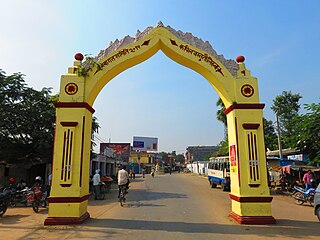
Kapilvastu is a municipality and administrative center of Kapilvastu District in Lumbini Province of southern Nepal. The municipality is located roughly 25 kilometres (16 mi) to the south-west of Lumbini, a UNESCO World Heritage Site and the birthplace of Gautama Buddha.

Mahāpajāpatī Gotamī or Pajapati was the foster-mother, step-mother and maternal aunt of the Buddha. In Buddhist tradition, she was the first woman to seek ordination for women, which she did from Gautama Buddha directly, and she became the first bhikkhuni.
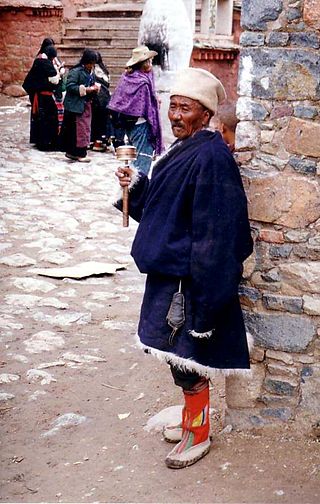
The most important places in Buddhism are located in the Indo-Gangetic Plain of northern India and southern Nepal, in the area between New Delhi and Rajgir. This is the area where Gautama Buddha lived and taught, and the main sites connected to his life are now important places of pilgrimage for both Buddhists and Hindus. Many countries that are or were predominantly Buddhist have shrines and places which can be visited as a pilgrimage.
Devdaha is a municipality in Rupandehi District of Nepal, the ancient capital of Koliya Kingdom, located 7 km east of Lumbini and east of Butwal and shares a border with Nawalparasi district on the east side. It is identified as the maternal home of Queen Mayadevi, Prajapati Gautami and Princess Yasodhara. There are many places to visit in Devdaha. It is believed that Prince Siddhartha had spent some years of his childhood with his step-mother/aunt Prajapati Gautami in Devdaha.

In religion and spirituality, a pilgrimage is a long journey or search of great moral significance. Sometimes, it is a journey to a sacred place or to a shrine of importance to a person's beliefs and faith. Members of every major religion participate in pilgrimages. A person who makes such a journey is called a pilgrim.
The Buddha was born into a noble family in Lumbini in 563 BCE as per historical events and 624 BCE according to Buddhist tradition. He was called Siddhartha Gautama in his childhood. His father was king Śuddhodana, leader of the Shakya clan in what was the growing state of Kosala, and his mother was queen Maya. According to Buddhist legends, the baby exhibited the marks of a great man. A prophecy indicated that, if the child stayed at home, he was destined to become a world ruler. If the child left home, however, he would become a universal spiritual leader. To make sure the boy would be a great king and world ruler, his father isolated him in his palace and he was raised by his mother's younger sister, Mahapajapati Gotami, after his mother died just seven days after childbirth.
Lumbini Development Trust (1985) or was founded for the purposes of restoring the Lumbini Garden under the master plan of the government of Nepal. Lumbini is the birthplace of Gautama Buddha, the founder of Buddhism, who was born in the 7th or 6th century BC.According to Buddhist tradition, Maya Devi gave birth to the Buddha on her way to her parents’ home in Devadaha in the month of May in the year 623 BC. Feeling the onset of labor pains, she grabbed hold of the branches of a shade tree and gave birth to Siddharta Gautama, the future Buddha. The Buddha is said to have announced, "This is my final rebirth" as he entered the world. Buddhist tradition also has it that he walked immediately after his birth and took seven steps, under each of which a lotus flower bloomed. In 249 BC, the Buddhist convert Emperor Ashoka visited Lumbini and constructed four stupas and a stone pillar. Ashoka's Pillar bears an inscription that translates as: "King Piyadasi (Ashoka), beloved of devas, in the 20 year of the coronation, himself made a royal visit, Buddha Sakyamuni having been born here, a stone railing was built and a stone pillar erected to the Bhagavan ["blessed one"] having been born here. Lumbini village was taxed reduced and entitled to the eight (8) part (only)".

Lumbini Province is a province in western Nepal. The third largest province by area and the third largest by population, Lumbini province is home to the World Heritage Site of Lumbini, where according to the Buddhist tradition, the founder of Buddhism, Gautama Buddha was born.
Lumbini is the place where Queen Mayadevi gave birth to Siddhartha Gautama in 563 BCE. There are number of historical Buddhist pilgrimage sites in Nepal.
Robin Andrew Evelyn Coningham, FSA, FRAS is a British archaeologist and academic, specialising in South Asian archaeology and archaeological ethics. He has been Professor of Early Medieval Archaeology since 2005 and UNESCO Chair in Archaeological Ethics and Practice in Cultural Heritage since 2014 at the University of Durham. From 1994 to 2005, he taught at the University of Bradford, rising to become Professor of South Asian Archaeology and Head of the Department of Archaeological Sciences.

The Lumbini pillar inscription, also called the Paderia inscription, is an inscription in the ancient Brahmi script, discovered in December 1896 on a pillar of Ashoka in Lumbini, Nepal by former Chief of the Nepalese Army General Khadga Shamsher Jang Bahadur Rana under the authority of Nepalese government and assisted by Alois Anton Führer. Another famous inscription discovered nearby in a similar context is the Nigali-Sagar inscription. The Lumbini inscription is generally categorized among the Minor Pillar Edicts of Ashoka, although it is in the past tense and in the ordinary third person, suggesting that it is not a pronouncement of Ashoka himself, but a rather later commemoration of his visit in the area.

World Peace Pagoda, also called Nipponzan Peace Pagoda, is a Buddhist monument in Lumbini, Nepal. It was designed and built by Japanese Buddhists at a cost about a million US dollars. The Pagoda acts as the starting point on the central axis of the Lumbini Master Plan, the other end being the Mayadevi Temple. The distance from the pagoda to the temple is about 3.2 km. The stairs in stupa lead to three different levels. The stupa is whitewashed and the floor is stone-paved. It has four large golden statues of Buddha facing four directions.
